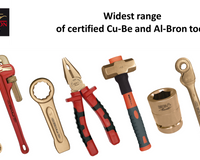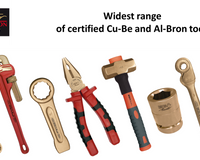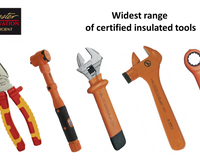The following are some of the misconceptions about non-sparking tools that we have come across through interactions with industrial companies:
1. Non-sparking tools do not generate any spark
Non sparking tools are made of metal, and as a result, they do generate sparks. The difference between non-sparking tools and steel tools is the energy of the spark they generate.
The low energy of the sparks is the result of the special alloys in the composition of non-sparking tools.
2. Copper Beryllium (Cu-Be) tools are more expensive than Aluminum Bronze (Al-Bron) tools
Even if Cu-Be tools are around 30% more expensive than Al-Bron non-sparking tools, they are 40 to 50% harder. As a result, Al-Bron non-sparking tools may be a more expensive option over time considering you might need to replace them more often.
Depending on the frequency of use, using Cu-Be non-sparking tools may be a more economical option in the mid to long run.
3. Plastic coated tools are safe to be used in explosive work environments
Even if plastic coated tools are likely safer than steel tools, they can´t considered to be a safe option considering that it is not possible to coat all active parts of a tool.
As a result, they are called spark reduction tools but not non-sparking tools. Their use is not recommended for the following reasons:
- They do not avoid the risk of explosion
- The plastic coating is susceptible to become damaged, further increasing the exposed areas
- The standard EN 1127-1 prohibits the use of steel made tools in most zones and groups of gas.
4. Cu-Be non-sparking tools are carcinogenic and therefore represent a health hazard
We have found out that there is some confusion about the impact that Cu-Be non-sparking tools could have in the user´s health.
It is true that beryllium in the form of dust, inhaled continuously over long periods of time has been proven to be cause lung cancer (for example in foundries where this alloy is melted and appropriate safety measures are not in place).
However, there is no evidence or recorded cases about Cu-Be non-sparking tools causing any cancer. Main reasons are:
- Cu-Be has only 2% of beryllium in its composition.
- It is not in powder form, so you do not inhale it.
- The exposure is minimal.
It is for the above reasons that there is no country in the world that has banned the use of this alloy.
5. Cu-Be non-sparking tools are always the safest option
Even if Cu-Be non-sparking tools are generally the safest option, there is one exception: the presence of Acetylene gas.
Even if Acetylene is a gas in the IIC group (and therefore safe for Cu-Be non-sparking tools), the gas reacts with any alloy with a copper composition higher than 65%, creating a new highly explosive compound called copper acetylide.
As both Cu-Be alloys and Al-Bron contain more than 80% of copper, they must never be used in acetylene environments. In such environments, steel tools would likely be safer than Cu-Be non-sparking tools.
For such environments, EGA Master has developed an alloy called ACETILEX®, which have less than 65% of copper in their composition. As a result, ACETILEX® non-sparking tools are the only completely safe alternative on the market for working in environments with acetylene.
Did you find this blog useful? You may also find these other posts interesting:
4 factors to consider when procuring non-sparking tools
Non-sparking tools: Learn the basic concepts and be safe!




